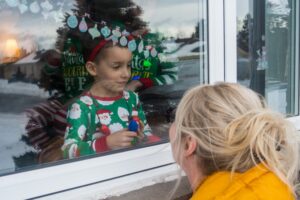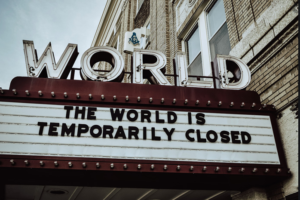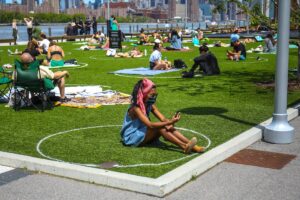January 15, 2021
The Environmental Psychology of COVID-19 with Professor Lynne Manzo
We are living through a new reality, adjusting to life during a global pandemic. We are all changing our routines, our travel plans, our holiday traditions. For those of us who have been able to keep our jobs through this economic crash, we have had to adapt to a new working environment, working from our homes. Some of us have transformed our homes to accommodate remote learning, and others have moved to be closer to family. Whatever your current living situation is, it’s almost assuredly different than it was a year ago.
It’s been many months, but College of Built Environments’ Professor Lynne Manzo thinks it’s more than fair to say we are still adjusting to our new way of living, all still figuring out how we move within the spaces we now inhabit differently.
As a trained environmental psychologist, Manzo is drawn to questions of how people inhabit spaces. Environmental psychology is an interdisciplinary social science that seeks to understand the interrelationships between people and place and the lived experience of place. As a testament to this interdisciplinary field, Manzo and her colleagues from around the world came together digitally. While there is a great deal of research on the pandemic from a public health or psychology point of view, Manzo and her colleagues felt something was missing. Their research paper, “Re-placed” – Reconsidering relationships with place and lessons from a pandemic, centers place in the discussion, recognizing place “not just as a static backdrop to what we are all trying to negotiate, but as an active agent in our lives,” says Manzo. “COVID-19 has brought our awareness of place to a whole other level [one] that we couldn’t have ever imagined possible.”
While we are intimately aware of the changes around us, we often express our experience in terms of social relations. “I miss my friends”, “I wish I could be home for the holidays”, “I would love to go out to dinner tonight”. All of those things may be true and Manzo doesn’t diminish these sentiments but points out that place also plays a critical role in our well-being and daily lives.
Manzo and her research colleagues break down the different forms of impacts the pandemic continues to have on our relationships to place with three dynamic axes or dialects.
The first dynamic in play is emplacement-displacement. Environmental psychologists have long said that as long as we’re in body, we’re embedded in place. The pandemic forces us to negotiate and create new relationships to place. Stay at home orders further cause us to reckon with the ways we utilize space and increase our awareness of the tensions and nuances of our relationship to place. While being able to work from home provides more flexibility, being at home more than usual can also feel restrictive. We are now entrenched in place and more aware of that emplacement, but at the same time, we’re experiencing displacement as we’ve become alienated from workplaces and other social settings.
The second dynamic is inside-outside, the idea that “[t]he inside and the outside of a place are intricately interwoven…”. The notion of coming home after a long day of work or of running errands and being able to come home, kick off your shoes, and relax in privacy has been upturned. There is a big tension between inside and outside now as “[t]he outside has invaded the inside of our homes, which used to be, for many, places of refuge and privacy. Now they have become proxies for schools, offices, pubs and fitness clubs.” Being able to have a private inside experience is now complex.
Interactions with the outside have been blocked on the behavioural (stay at home), psychological (fear of the dangerous and uncontrollable virus), and community (social distancing) levels. – “Re-placed”
As a repercussion of the “blocked psychological access” to the outside, communities are seeing an increase in domestic violence cases. Other effects we’re seeing in society are an increase in socially conservative attitudes, xenophobic (Jetten, Reicher, Haslam, & Cruwys, 2020) and racist attitudes around who is to blame for the virus (Devakumar, Shannon, Bhopal, & Abubakar, 2020), and conspiracy theory driven violence (Jolley & Paterson, 2020).
The disruption — one we are all experiencing — of the inside-outside relationship gives us the opportunity to rethink and expand our understanding of place as an isolated entity.
The third dynamic is fixity-flow. Manzo says this may be the most obvious tension. Fixity-flow captures the tension between being pinned to place in some aspects, but more digitally mobile, something we’ve become quite familiar with. We may be connecting with people from places much further away than we normally would while still being “locked down” at home. We may not be seeing friends and family in person, but we’re able to connect with them via online tools and doing so more frequently.
The reason why we wanted to identify these as dialectics or tensions is that you don’t fully appreciate one unless you have the other. – Professor Lynne Manzo
The three dynamic axes provide a framework for understanding the contradicting ways in which we are experiencing place. From there, the research identifies six implications of COVID on our relationships to place. The research’s goal was not to be comprehensive but to outline possible next steps for research.
There have always been challenges in how much our homes are truly a haven. Manzo believes that we romanticize home and says that if COVID-19 has taught us anything it’s about all of the complexities and realities around our relationships to whatever we call home. The first implication, home-making and un-making, examines the ways the pandemic has altered and redefined the meanings and functions of our everyday spaces.

Photo by Andre Ouellet
“For example, in Chile (CUIDAR, 2020) the pandemic has meant that the home is reconfigured for women as a space with a greater burden of care work (cooking, cleaning, disinfection tasks, maintaining a harmonious space, generating space to share and contain telework, distance education of children, pet care, etc.), and they have had to adapt to fulfill new roles in different spaces and times.”
On the other hand, the COVID crisis could allow us to create “alternative, complex imaginations of home…” those about collectivity and care. The research states that in doing this re-imagining it has the potential to “de-center the patriarchal, capitalist, colonial imaginaries of home, women, and domesticity.” We again see dichotomies at play in our experience of place during this pandemic.
Future research questions:
1: How has the pandemic altered our relationships to home? In what new ways do people make and unmake homes in the pandemic?
2: What alternative narratives, discourses and imaginations of the home emerge in the context of the pandemic? How do these alternatives impact the ways in which we live and make home?
Not everyone has the privilege of working from home and not everyone has a home. Essential workers are ensuring services are accessible, taking care of sick patients, and keeping us fed. Their relationship to place, their workplace, is different from those of us working at home. We are experiencing the effects of the pandemic in a multitude of ways and this reality led to the next implication, oppressive “homing”, exclusion and socio-spatial precarity.
Home confinement makes visible the everyday politics of home, connecting the private sphere with social conflicts and socioeconomic structures. – “Re-placed”
BIPOC communities and communities with low-incomes live precarious lives and COVID is only compounding that. While the research team says more research should be done on “non-normative” experiences, Manzo asks us to stop romanticizing home and recognize how complicated our relationships to home can be. She notes that we often marginalize people who feel like home is a trap for them. She wonders now that more of us have been stuck at home, whether we can appreciate that home isn’t all roses and that it’s multi-faceted. Manzo hopes it will help us be more compassionate towards people who up until now have had their experience of place invalidated. “Re-placed” – Reconsidering relationships with place and lessons from a pandemic urges future research to have a critical eye towards “non-normative, oppressive and exclusionary home-experiences.”
Future research questions:
3: How might the pandemic be intensifying forms of inequality, socio-spatial precarity and residential segregation? In what ways has it reinforced and/or contested existing geographies of privilege?
4: How can ambivalent, non-normative, oppressive and exclusionary home experiences in the pandemic problematise and reconfigure the “normal” inequality and exclusion in cities?
5: In what ways has the pandemic displaced people from their homes and other meaningful places, both physically and psychologically, and who is more vulnerable to such displacement?
Manzo asserts that public spaces are complicated as well, bringing about the next implication, A new politics of public space? Rethinking the right to the city. We’ve seen changes in our public spaces and seen the redesigning of urban spaces, like temporary or permanent street closures or widening sidewalks. The way that public space has been used in the past is being put to the test. It’s forced us to examine who has the “right to the city” (Mitchell, 2003). As cities think to the future, there’s an opportunity to design in a way that considers the needs of our unhoused neighbors and others who are often chastised for inhabiting public spaces.
Future research questions:
6: How has the pandemic changed the design and planning of urban public spaces and what are the impacts of these design and policy changes for place experience?
7: How is the normative re-definition of the meanings (moral, political, legal), uses, and functions of public space re-shaping socio-spatial behaviours in public, and to what extent will these behaviours stabilise?
8: How is this re-definition of public space interacting with the right to the city and fuelling the construction of a renewed conception of “the good citizen”?

Photo by Edwin Hooper
The conversation around urban public spaces takes us to recreational outdoor spaces, and the next implication, Health, wellbeing and access to ‘outside’ recreational spaces. Despite lockdowns or stay-at-home orders, being outdoors is important to our physical and mental health and one of the safer ways to interact with people, another example of the complexity of public spaces. With the reopening of hiking trails in the Seattle area, we saw an influx of people rush to get out for fresh air. While trying to listen to the experts’ advice to get outside, it created problems in trying to adhere to social distancing guidelines.
Getting outside and breathing in fresh air doesn’t only benefit people. Research shows that “changing patterns of recreation may have positive environmental outcomes, reducing carbon emissions associated with plane and car travel, with the potential to shift norms towards “slow travel” by bike and walking (Barr, 2018).”
So get outside for your mental health, physical well-being, and the health of our environment.
Future research questions:
9: What are the consequences of extended periods of home confinement, which disturb inside/outside and fixity/flow dialectics of place experience, on health and wellbeing, particularly for children and vulnerable adults?
10: How has the pandemic, and associated lockdowns, altered discourse and behaviour in relation to recreation and residency, specifically between urban and rural areas and new norms of teleworking? Could this lead to new norms that positively respond to the climate emergency?
Manzo and her colleagues applied the inside-outside dialectic as a lens to view the fifth implication, environmental perception revisited: re-sensing place, virtual escapes and fluid places, or virtual realities as Manzo put it. Facetime with friends, Zoom meetings and family gatherings, and online religious services, are all redefining “the very nature of place.” The use of our phones and other digital devices “allows virtual trespass of the physical thresholds of confinement, thereby breaking the spatial and social boundaries imposed by fixity, and mitigating negative feelings of displacement associated with confinement at home.” While we have the ability to use digital tools to connect or escape, the line between inside and outside and virtual and physical reality continues to blur.

Photo by Scott Lynch from the Gothamist
Future research questions:
RQ11: How is the global rise of virtual and multilocal modes of social encounter (i.e., flow) re-shaping the nature, meanings and social-psychological functions of physical places and people-place bonds?
RQ12: How does the blocking of sensory input during the pandemic due to a lockdown, forced immobility, and virtual social encounters affect our experience of place and the meanings assigned to places?
The last implication, methodological orientations and ethical considerations, serves as a reminder for the stated intention of “Re-placed”. Manzo and her colleagues want to get us thinking deeper about the implications of COVID on space and ensure that future research is inclusive of the myriad of ways it affects peoples’ lives.
The idea of resilience is often the idea of bouncing back, suggesting we’re going back to some previous state. Manzo points out that that’s not really what resilience is. No one has a crystal ball, Manzo says, but she knows we aren’t going back to some pre-pandemic norm, in terms of the way we move around and use space. Even without a crystal ball, she hopes that going forward we continue to prioritize ways of making and keeping our cities and public spaces accessible and more inclusive.
Professor Manzo believes that members of the College of Built Environments, with departments all concerned about place and designing for a better future, are poised to be thought leaders and innovators in achieving this.
